How to Buy a Good Camping Air Mat or Sleeping Pad
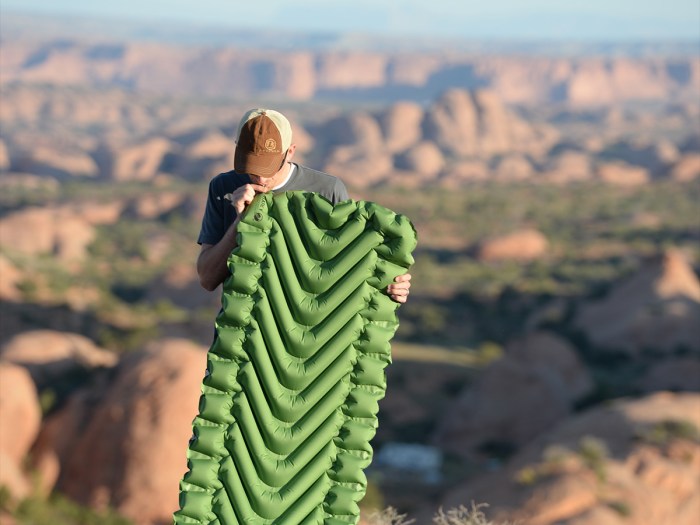
- Click here for the Gear Guy’s sleeping bag buying guide
- Find expert tips to help you get a good night’s sleep
You might not think your sleeping pad or air mattress is important until you spend a miserable night on a bad one. Follow these buying tips and grab a top pick.
SLEEPING PAD BUYING GUIDE
There are two types of sleeping pads:
Closed-cell foam pads: These simple pads insulate well and are lighter, cheaper and more durable than air mats. But they’re also much bulkier and usually need to be carried under external straps on a pack rather than inside it.
Air mats: With lots of choices in a range of prices, air mats are far superior in comfort to foam pads.
Self-inflating air mats mostly inflate when unrolled but usually require a few breaths to firm up. Other mats come with a small pump or sack with a mating valve for inflating.
Air mats are lightweight and pack down enough to fit inside your backpack. For three-season backpacking, air mats typically weigh under 1½ pounds and roll up to slightly larger than a liter bottle.
CONSIDER THESE FACTORS BEFORE CHOOSING A SLEEPING PAD
• Air mats occasionally puncture and go flat. Many come with a patch kit, but it can be difficult to locate a hole and repair it in the field. A mat’s denier rating indicates how strong its fabric is. The lower the rating, the softer — but lighter — the mat will be. A high denier rating means the fabric is tough but heavier.
• The standard size for sleeping pads is 20 x 72 inches. Taller than 6 feet? Most manufacturers make a larger size, but it’ll cost you.
• Some air pads make loud crunching noises when you shift around on them, which can be an annoyance to tentmates.
• For car camping, there’s almost no limit on size, so don’t fret over buying a lightweight backpacking air pad. A bulky air mattress — or old school cot — will do the job.
• Before buying, make sure the mat or pad is comfortable to you. The energy you lose through a bad night’s sleep will far exceed the energy you save by carrying a lighter pad on the trail. Make sure you get a pad on which you can sleep comfortably.
WHAT’S THE R-VALUE?
Sleeping pads and air mats are not just for padding. They also protect you in chilly temperatures and provide critical insulation against the ground. The R-value measures how well it insulates:
• An R-value below 3 indicates minimal insulation, adequate only for warm nights.
• A value of 3 or higher denotes a mat with insulation for camping on cool nights (above freezing temperatures). Chronically cold sleepers should find a mat rated closer to 4.
• Look for 5 or higher for camping on frozen ground or in sub-freezing temperatures.
GEAR GUY’S TOP PICKS FOR SLEEPING PADS AND AIR MATS
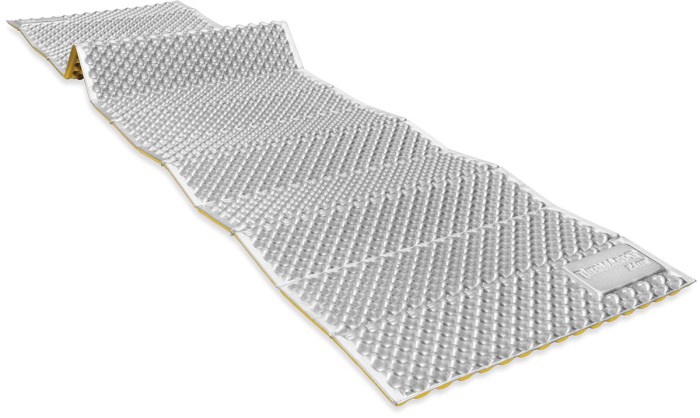
Outdoor beds don’t get simpler or cheaper than a foam pad, and the THERM-A-REST Z LITE SOL ($36, thermarest.com) sets the standard in this category for packability, durability and low weight — if minimalist on comfort. (Tip: Look for soft ground like pine needles or sand.) This egg-carton pattern closed-cell foam pad folds up like an accordion and lies flat when you open it up, and it has a heat-reflecting surface. But at 3⁄4 inch thick and a 2.0 R-value, it isn’t super comfy. 14 oz.
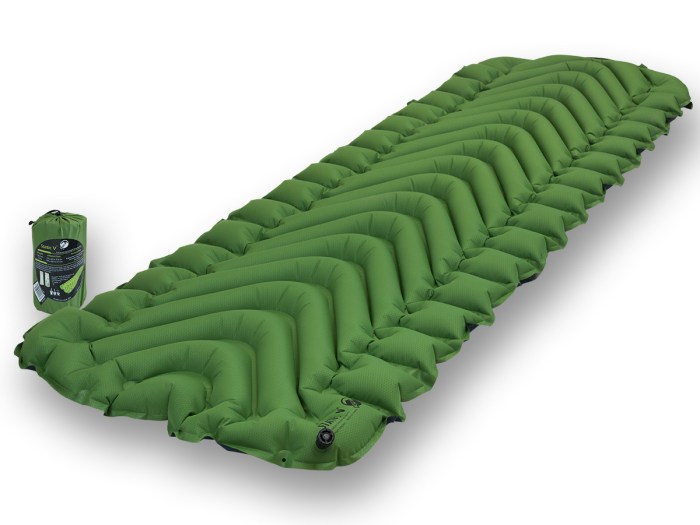
With 2 1⁄2 inches of thickness, body-conforming chambers and numerous air pockets, hard ground goes soft on the KLYMIT STATIC V ($60, klymit.com). The typical 72-inch length gets a comfort boost from the 23-inch width, more than many regular air mats, while the 75-denier polyester shell fabric is tougher than what many competitors use. It’s still just a few ounces north of a pound. 1 lb. 3 oz.
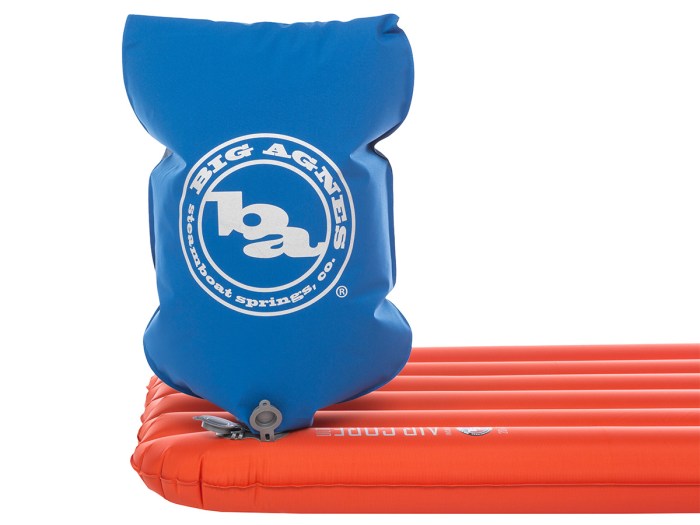
At 3 1⁄4 inches thick with outer chambers to keep you on the mat, the BIG AGNES INSULATED AIR CORE ULTRA ($80, bigagnes.com) delivers deluxe comfort at a good value, reasonable weight and low bulk. Separate high-volume valves and an upcycled inflation sack make inflating and deflating quicker. Synthetic insulation and heat-reflective technology give it an R-value of 4.5, good for nights around freezing. Nylon ripstop fabric and aviation-grade thermoplastic polyurethane lamination improves durability while minimizing weight. 1 lb. 6 oz.
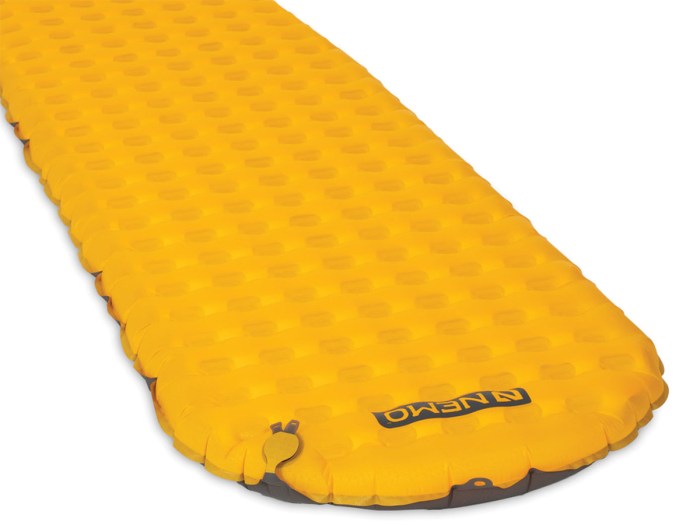
Three inches thick, with waffle construction that improves stability and distributes weight evenly, the NEMO TENSOR ULTRALIGHT INSULATED SLEEPING PAD ($190, nemoequipment.com) inflates quickly using a Vortex pump with a micro-adjustable valve for precise inflation control. This saves your breath and minimizes moisture (a heat conductor) entering the mat. Two layers of suspended metalized film keep the mat quiet. This year’s updated model uses a continuous thermoplastic polyurethane film to prevent convective heat loss, raising the R-value from 3.5 to 4.2 — without any weight gain. 15 oz.
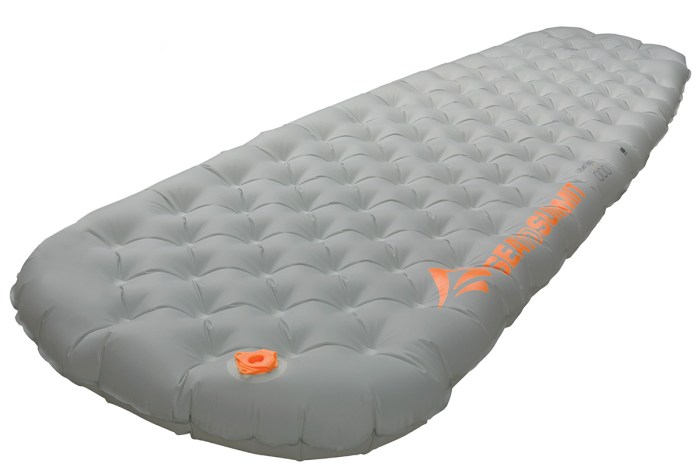
For starters, the SEA TO SUMMIT ETHER LIGHT XT INSULATED AIR SLEEPING MAT ($180, seatosummit.com) blends two types of insulation: a quiet, non-woven fabric with a metalized layer that reflects radiant heat and a hollow-core insulation that lofts to prevent convective heat loss, giving this mattress an R-value of 3.2. At 4 inches thick, the Ether Light XT incorporates a matrix of interconnected air chambers that conform to your body. Its 21 1⁄2-inch width at the shoulders exceeds most regular-sized mats, and it weighs barely more than a pound. 17.3 oz.
Hi! I am going camping for scouts and I need a small sleeping pad for a tent about the width of my body so that I don’t bother my tentmate(s). Any suggestions?
Hikenture also makes good sleeping pads.
I love my ALPS Mountaineering self inflating mattress.
The sleeping pad is making me want to go camping.
“A scout is thrifty”. Why does boyslife continue to push $100+ gear when $30 gear is sufficient? And don’t say “I can afford it”. If you can afford a $100+ pad, buy a $30 pad and put $70 towards sending an underprivileged boy to summer camp.
Scouting as a whole has gotten expensive, hasn’t it?
Quality gear is expensive, many times a scout is overloaded on the trail,because of a “be prepared” mentality. Use common sense and she’d as much weight as possible. Unfortunately light=expensive.
My father told me to always buy the best quality tool you can afford, these items are tools that allow you to enjoy your hike, not suffer through.
Thermarest selfinflating matresses. Using them for 30 years. Just got a new one last year for me and one last month for my son. Z-rests for our ultralights.
I have the Big Agnes Air Core Ultra and it is awesome!
Walmart is cheep
Try a Cabela’s cot or sleeping pad! They are AWESOME!!!!!
WalMart’s Ozark Trail dome tent is pretty cool, 2.
This is not about tents.
I have an eno singlenest. It is awesome for the price
Check out the Big Agnes insulated air core for us arctic campers.
I have the sea to summit pillow shown and the alps foam pad. Together with an ozark trail sleeping bag works pretty good for pretty cheap.
I just like to sleep on the bare ground and I like to not sleep in a tent or hammock the ground is my choice.
60%-75% of your body heat is lost thru the ground. At least one sleeping pad is a must. Even if it is really warm at night, a sleeping pad can also add extra comfort.
If you can do this comfortably you are an experienced camper. Kudos to you for being an advanced camper; I too do the same thing when ever possible. A true ultra light camper learns these sort of things and can really lighten their gear load, it’s not unheard of to have a 6# pack for a 3 day outing; including food. I dehydrate my own meals to reach that weight though.
Hey Gear Guy,
could you post something about the therma-rest trail scout
Thanks!
Get a compression sack for your clothes, and sew a peice of fleece on the outside. Sleep on the fleece patch. This is very light and minnimises carying a pillow and a compressoin sack.
Thanks for all the info. I’m in my 2nd year of scouts and trying to learn as much as possible. I’ve read all the info that I could about sleeping bags and liners online, but nothing I could find explained it as well as you did. I learned more in the 20 minutes on this page than the 20 hours of my research prior. Thank you for this site!
buy hte Big agnes air core pad! affordable, and its as comfy as unicorn fur on cloud of cotton candy!
nice metaphor
If you really like a pillow, try an inflaitable one. I bought 3 at Wal-Mart about 4 years ago and take one on my backpacking trips simply because they pack so small, so why not. It can inflate from 1/2 – 3″ high and 17′ long. It has 1″ of open cell foam build into the fleece pillow case for extra comfort. I found them on sale for $4.00 each. I used to use a large ziplock 1/2 filled with air and wrape my fleece jacket around it; the air pillow is more solid and less noisy. I don’t roll up my clothes as a pillow because either they’re dirty and smell or I’ll sweat on my clean clothes making them dirty before I wear them.
I bought one from Target and its lasted me 5 years!
You’ll need to cut an X in a tennis ball and put one over each leg/foot of your cot or you will poke a hole in the bottom of your tent. Or get a cot that has a continuous length of tubing across the bottom where it touches the floor.
Good idea! the legs of my cot are too big for that so i put socks on them.
My vote goes to the Thermarest NeoAir. It’s nice packing my pad away in my bag rather than strapped to my gear loops on the outside.
Never ever use pillows…They weigh you down on backpacking trips and they can be replaced easily with a bundled up sweatshirt. Most also become obsolete when wet.
I agree with the pillows except I have a bad neck so I use a total pillow in my hammockthe small total pillow is tiny it can support my neck and I have a water proof case for it.
if you have an inflatable sleeping pad, just stick sum thing underneath the head part to prop it up a bit. that way, you don’t need to bring a pillow and your head is propped up.
Isn’t this the same guy that couldn’t have a 4 ounce compass on his watch because it “was to heavy”?
yes
So what makes you think a 4 ounce compass on you watch is going to slow you down?
Yes -stuff the sweatshirt into its own sleeve for a comfortable pillow. It won’t unfold during the night.
I have one of those Sea To Summit sleeping bag liners. I take it on short summer skiing and mountaineering trips when there is still snow on the peaks. It turns my 30 degree bag into a fifteen degree bag! my liner works great!
I use the awesome Term-a-Rest Trail lite pad. I use the small. Although, it doesn’t cover you completly, it still is great and keeps me warm. It is really lightweight too!
This is totally rockin’!
cool
exped mats and pillows are amazing!
I use a exersize mat from wal-mart its cheap, light, and really comfortable. It came with its own strap so i just hook it to my pack. It works great!
For my Sleeping Pad.
The Slumberjack Super Guide 30 degree sleeping bag is awesome.
I use a Big Agnes Air Core sleeping pad. The pad is full length, with 2.5 inches of thickness. It’s great for backpacking because it weighs only 22 ounces and packs down to the size of a Nalgene bottle!
Exped pillow is 3 oz and inflatible.
thermarest is the best for there sleeping pads and pillows
I like LL Bean all the way for this kind of thing!
I never know what liners were till now!
I use the aircore ultra insulated, long and it is better than my therma-rest for space, weight and comfort.it may be expensive, but well worth it when it is time to bed down for the night. Thrifty has its place, but buy the best that you can afford,and you will find that you “buy once, cry once”.
thermarest pillows work great for backpacking
I found a sleepin ba that keeps you warm to temperatures down to -57 Degrees. It is in the $50 to $100 range.
Is there a specific link to the 100th anniversary slleping bag? I am having trouble finding it.
Try the Cocoon Airsore Pillow instead. It weights 2 ounces and takes up barely any room.
Aircore i mean.
thanks for the nice selection
it is awesome
It is very helpful to now how I can buy all the stuff I need.
i have found that a sleeping pad is very important for cold weather